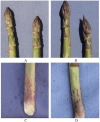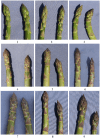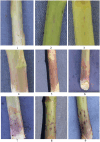Genetic architecture of anthocyanin pigment traits and purple spot (Stemphylium vesicarium) resistance in an F1 pseudo-testcross population of asparagus
- PMID: 40204667
- PMCID: PMC11981981
- DOI: 10.1002/tpg2.70028
Genetic architecture of anthocyanin pigment traits and purple spot (Stemphylium vesicarium) resistance in an F1 pseudo-testcross population of asparagus
Abstract
Stemphylium vesicarium (Wallr.) Simmons is a plant pathogenic fungus causing purple spot in both fern and spears of asparagus (Asparagus officinalis L.). Although the fern can be sprayed with fungicides to control the disease, pesticide applications during spear harvest are restricted. Infected spears can develop prominent pigmentation at lesion sites, reducing marketable yield. Breeding resistant asparagus cultivars with decreased lesion numbers and reduced purpling at the site of infection is considered the most economical and sustainable approach to combat this disease. The objectives of this study were to determine the genetic architectures of, and relationships among, anthocyanin pigment expression in spear scale leaves (ALS) and spear lesions (APS) and purple spot levels in spears (NPS) and fern (PSF). Traits were phenotyped over 2 years under natural conditions in an F1 pseudo-testcross population, and quantitative trait loci (QTL) were mapped. ALS, APS, NPS, and PSF were not correlated, suggesting independent regulation of the anthocyanin pathway in scale leaves and lesions and no relationship between pigment and disease. Segregation, 3 red:1 purple and 3 red:13 purple, was observed in scale leaves and lesions, respectively. Two stable QTL for each of ASL, APS, and NPS, one tentative QTL for ASL, four tentative QTL for APS, two tentative QTL for NPS, and three tentative QTL for PSF were identified. Candidate genes were found for four loci. This study advances the genetic understanding of anthocyanin pigmentation at a tissue-specific level, and purple spot disease severity in spears and fern, supporting future breeding efforts.
© 2025 The Author(s). The Plant Genome published by Wiley Periodicals LLC on behalf of Crop Science Society of America.
Conflict of interest statement
The authors declare no conflicts of interest.
Figures




References
-
- Aravind, J. , Mukesh Sankar, S. , Wankhede, D. , & Kaur, V. (2021). augmentedRCBD: Analysis of augmented randomised complete block designs (Version 0.1.2) [R package]. Comprehensive R Archive Network (CRAN). https://aravind‐j.github.io/augmentedRCBD/
-
- Asen, S. , Stewart, R. , & Norris, K. (1972). Co‐pigmentation of anthocyanins in plant tissues and its effect on color. Phytochemistry, 11(3), 1139–1144. 10.1016/S0031-9422(00)88467-8 - DOI
-
- Austin, G. (2023). A bioassay for asparagus (Asparagus officinalis L.) resistance to Stemphylium vesicarium [Master's thesis, University of Guelph]. https://atrium.lib.uoguelph.ca/items/28574f99‐6357‐43c4‐afd8‐fde53ad0c0e2
-
- Bannoud, F. , Carvajal, S. , Ellison, S. , Senalik, D. , Gomez Talquenca, S. , Iorizzo, M. , Simon, P. W. , & Cavagnaro, P. F. (2021). Genetic and transcription profile analysis of tissue‐specific anthocyanin pigmentation in carrot root phloem. Genes, 12(10), 1464. 10.3390/genes12101464 - DOI - PMC - PubMed
-
- Bartlett, M. S. (1937). Properties of sufficiency and statistical test. Proceedings of the Royal Society A, 160(901), 268–282. 10.1098/rspa.1937.0109 - DOI
MeSH terms
Substances
Grants and funding
LinkOut - more resources
Full Text Sources
Miscellaneous

